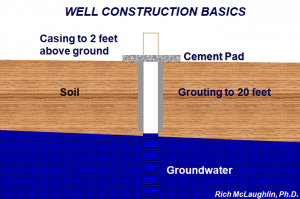Abandoned Wells
Unless old wells are properly filled, sealed, and plugged, they can allow pollutants to contaminate other wells that draw from the same groundwater source or aquifer. An unused well is a direct route to the ground water.
To seal an unused well properly, you need to make sure that a new barrier is created that restores the isolation/protection of the groundwater. A well that has been permanently closed by approved methods is considered an abandoned well. A certified well contractor should be used to abandon the well. In some states, well owners may abandon their own wells if it is done according to state regulations. The requirements for abandonment differ by type of well.
Active Wells
Active wells may also become sources of groundwater contamination if pesticides leak into them. Inspect well casings for cracks or other damage, and make sure that the casing extends at least 24 inches above the soil level. The top of the casing should be sealed with a well cap or rubber grommet.
 The grout seal between the well casing and the borehole walls should also be checked for signs of cracking. Required well casing and grout depth vary from state to state, and even within states, depending on soil characteristics.
The grout seal between the well casing and the borehole walls should also be checked for signs of cracking. Required well casing and grout depth vary from state to state, and even within states, depending on soil characteristics.
It is a good idea to test well water once a year for bacteria, nitrates, and other contaminants. Even if you are protecting your well, it may still become polluted from contaminants entering the aquifer some distance away from the well.
Original content compiled by:
